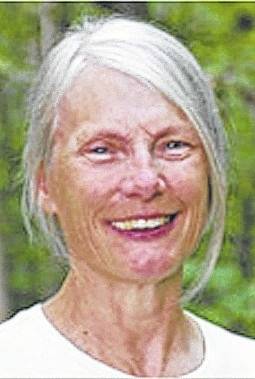
On Tuesday, Jan. 7, farmhands and gardeners were happy to return after the holidays to volunteer at Stratford Ecological Center on Liberty Road. The day turned out to be a mild one, which was fortunate as there were urgent outside jobs awaiting the farmhands. The gardeners had plenty of transplanting and weeding in the greenhouse and welcomed the extra warmth and the eye tonic of lush greens.
Farmer Jeff had fed the last of the feed to the hens and hogs that morning, and ration mixing was a priority. The only problem was there was no corn on hand, only the ears in field 3. A quick check showed that many of the kernels had little dimples, a sure sign they were dry enough to harvest. The land, however, was not sufficiently dry to withstand a tractor and our one-row corn harvester.
But many hands make light work, and the farmhands set to, snapped off, and husked 1,152 ears, or 24 bushels assuming four dozen ears/bushel, which weighed 1,000 pounds. In next to no time, they were in the auger and rotating their way up into the mixer to join the hay, soybeans, and minerals.
In the future, if the ground is frozen, the corn can be harvested mechanically, otherwise it will be all-hands-on-deck again. The picking was a satisfying first for many, but it’s probably a good thing there is less than an acre as that would mean picking 12,000 to 24,000 ears!
The orchard hens are faring well. Due to their large numbers, the coup requires cleaning out every three to four weeks. It is a job I have never gravitated to and is usually reserved as a “treat” for the young agriculture interns. They are not here in the winter and Carol, a farmhand who mows in the Children’s Garden during the season, volunteers for the job. She is a trooper as the work requires shooing the hens out into the orchard, opening the back door onto the lane, and scraping the perches, then emptying the nesting boxes of straw, and sweeping everything outside. She allows other farmhands to load and drive it to the manure pile in the field, where the urea adds some excellent nitrogen. Everyone is thankful for willing folks like Carol.
An enterprising young man just old enough to have his driving license delivered the last of the hay needed for this season. It turns out this young man has a piece of grassland to make hay and has an agreement with other farmers. It’s not a rich hay including alfalfa or clover, but a mix of Timothy and Orchard grass, which will satisfy the livestock most of the time. The teenager recognized that this year there would be a high demand for hay due to the weather pattern and with a strong work ethic, he cut, baled, picked up, delivered, unloaded and stacked the hay for farmers willing to pay $5 per bale. Today, when less than 2 percent of the population are farmers, I would say his actions were impressive, not to mention the money in his bank account. He would be a great candidate as an agriculture intern.
A belated and welcomed Christmas gift from a farmhand was a new log splitter for our maple sugar operation. We have an older model, but it cannot be used vertically like the new model to split massive trunks. Instead, the men must lift the trunks onto the splitter, and that can be a challenge.
A good looking 2-year-old pure Tunis ram called Sir Patrick was donated to us this month by Kathleen Freeman. We still have 12-year-old Rusty, who joined the ewes to mate last October. He is not as strong these days and requires a break every now and again, but we are not ready to part company just yet. Sir Patrick will act as a mop-up ram to ensure all the ewes are in-lamb.
The Friday before Christmas when the staff were off site having a celebratory luncheon, Jennifer, a weekly gardener, came in to check on the calf born the previous Friday. She found him faring well after a rocky start and then noticed a Red Devon Cow showing signs of giving birth. This would be the third arrival in the last month sired by Jack-o-Lantern before we could get him off to market! Jennifer immediately called Farmer Jeff to return, and a little later, a healthy bull calf was born without assistance.
Thanks to a farm and nature guide’s connection, a gentle Berkshire/Poland China in-pig sow will be donated in February. The Poland China was first bred in Ohio in 1816 and is the oldest breed in America. This will be her second litter, and she is due between March and May. Piglets are a favorite with the school children and will be most welcome, especially as two of our former piglets are now fully grown and left for the processor on Jan. 14. The third hog will go in February. The hogs are desirably lengthy and in very good condition as 25 percent of their ration this winter was constantly donated protein-rich acorns.
Looking ahead, maple sugar guides are needed for school tours and two Saturday morning tours in February. Training is scheduled for Thursday, Feb. 13, from 10 a.m. to 1 pm. If interested, please call for more details.
There are other education programs planned for February, and they can be found on our web site. Whatever the upcoming weather, we hope you will visit and enjoy your time with us.


